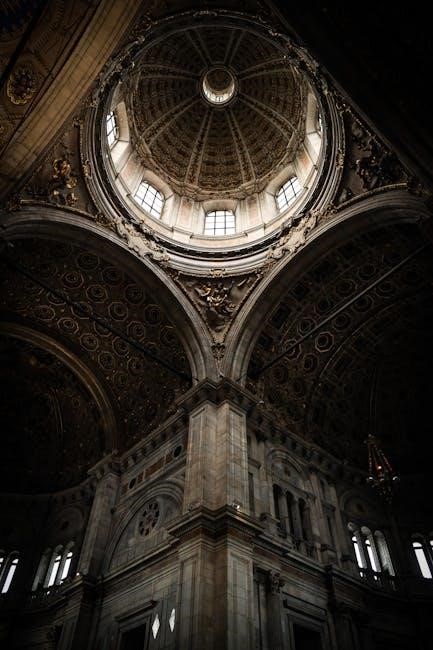The Rosary is a traditional Catholic devotion, combining prayer and meditation on the life of Jesus and Mary. It consists of specific prayers and reflections, making it accessible to all.
What is the Rosary?

The Rosary is a traditional Catholic devotion combining prayer and meditation on the life of Jesus Christ and the Virgin Mary. It consists of a sequence of prayers, including the Our Father, Hail Mary, and Glory Be, recited while reflecting on sacred mysteries. These mysteries, divided into categories such as Joyful, Luminous, Sorrowful, and Glorious, depict key events in the lives of Jesus and Mary. The Rosary is typically prayed using a set of beads to count the prayers and meditations, fostering contemplation and spiritual growth. It is a popular form of vocal prayer that has been encouraged by the Church for centuries, offering comfort, guidance, and a deeper connection to faith.

Benefits of Praying the Rosary
Praying the Rosary offers numerous spiritual and emotional benefits, fostering a deeper connection with faith and fostering inner peace. It provides a structured way to meditate on the life of Jesus and Mary, promoting contemplation and reflection. Regular recitation of the Rosary helps cultivate virtues such as humility, patience, and love. It also serves as a powerful tool for seeking guidance, comfort, and strength in difficult times. The repetition of prayers like the Hail Mary and Our Father creates a calming rhythm, aiding in mental clarity and focus. Many Catholics find solace in the Rosary, using it to express gratitude, seek forgiveness, or intercede for others. Additionally, praying the Rosary is believed to bring divine protection and blessings, enriching one’s spiritual journey and fostering a closer relationship with God.

The Structure of the Rosary
The Rosary is a prayerful devotion structured around sacred mysteries, combining vocal prayers and meditation on key events in the lives of Jesus and Mary.

The Basic Prayers of the Rosary
The Rosary is built around a few essential prayers: the Sign of the Cross, the Apostle’s Creed, the Our Father, the Hail Mary, and the Glory Be. These prayers form the foundation of the devotion. The Our Father is recited at the beginning of each decade, followed by ten Hail Marys and a Glory Be. This repetition creates a rhythm that aids in meditation and reflection. The prayers are simple yet profound, expressing devotion to God and Mary while inviting contemplation on the mysteries of faith. By focusing on these prayers, the Rosary becomes a powerful tool for spiritual growth and connection with divine grace.
The Mysteries of the Rosary
The Rosary is structured around four sets of mysteries, each representing key events in the lives of Jesus and Mary. These mysteries—Joyful, Luminous, Sorrowful, and Glorious—are meditated upon while praying the decades. Each mystery is announced at the start of a decade, guiding the prayer and reflection. The Joyful Mysteries focus on the early life of Jesus, while the Luminous Mysteries highlight His public ministry. The Sorrowful Mysteries reflect on His passion and death, and the Glorious Mysteries celebrate His resurrection and Mary’s assumption. Meditating on these mysteries deepens understanding of the faith and fosters spiritual connection. The mysteries are typically prayed according to a weekly schedule, offering a structured path for contemplation and devotion.

How to Pray the Rosary
To pray the Rosary, begin with the Sign of the Cross, recite the Creed, then pray the Our Father, followed by three Hail Marys. Continue with the Glory Be, meditate on each mystery, and conclude with the Hail Holy Queen.
Step-by-Step Guide
To pray the Rosary, begin with the Sign of the Cross. Recite the Creed, followed by one Our Father and three Hail Marys. Then, say the Glory Be. For each mystery, announce the title and pray ten Hail Marys, reflecting on the mystery. After each decade, recite the Glory Be and the Fatima Prayer. Conclude with the Hail Holy Queen and the Sign of the Cross. This structured prayer helps deepen meditation on the life of Jesus and Mary, fostering spiritual connection and peace. The Rosary’s rhythm combines vocal prayer with contemplation, making it a powerful devotion for Catholics worldwide. Its repetitive nature allows for focus on divine grace and intercession, creating a meaningful spiritual practice. Regular prayer of the Rosary is encouraged for its many spiritual benefits and as a way to honor the Blessed Virgin Mary. This guide provides a clear path for those seeking to pray the Rosary devotionally.
The Role of Meditation
Meditation is a cornerstone of the Rosary, transforming it from a mere recitation of prayers into a profound spiritual encounter. As one prays, they are encouraged to reflect on the mysteries, contemplating the life of Jesus and Mary. This practice fosters a deeper connection to the divine, allowing the prayers to become a heartfelt dialogue. Meditation helps the mind and soul focus on the sacred events, drawing spiritual nourishment from them. It is not merely about repeating words but about engaging with the meaning behind them. Through meditation, the Rosary becomes a powerful tool for inner peace, fostering a deeper understanding of faith and a closer relationship with God. This reflective dimension makes the Rosary a rich and transformative devotion, inviting believers to encounter the divine in a personal and meaningful way. Regular meditation during the Rosary enhances its spiritual benefits, making it a cherished practice for many.

The Mysteries of the Rosary
The Rosary’s mysteries are categorized into four groups: Joyful, Luminous, Sorrowful, and Glorious. These reflections on key events in Jesus and Mary’s lives guide meditation and prayer, deepening faith and connection to divine love.
The Joyful Mysteries
The Joyful Mysteries are a series of five reflections on the early life of Jesus and Mary, celebrating moments of divine joy. They include:
- The Annunciation: Gabriel announces Jesus’ birth to Mary.
- The Visitation: Mary shares the news with Elizabeth.
- The Nativity: Jesus is born in Bethlehem.
- The Presentation: Mary and Joseph present Jesus in the Temple.
- The Finding in the Temple: Jesus is found preaching at age 12.
These mysteries emphasize Mary’s role and the joy of God’s plan, offering a deep connection to the Holy Family’s life and virtues, fostering gratitude and trust in divine providence.

The Luminous Mysteries
The Luminous Mysteries, introduced by Pope John Paul II, focus on key events from Jesus’ public life, revealing His divine nature. They are prayed on Thursdays and include:
- Baptism in the Jordan: Jesus’ baptism by John, marking the start of His mission.
- Wedding at Cana: Jesus’ first miracle, showing His power and Mary’s intercession.
- Proclamation of the Kingdom: Jesus preaches the Gospel, calling all to conversion.
- Transfiguration: Jesus’ glory is revealed to Peter, James, and John.
- Institution of the Eucharist: Jesus establishes the Sacrament at the Last Supper.
These mysteries illuminate Jesus’ identity and mission, deepening meditation on His teachings and divine light, fostering spiritual growth and devotion to His public ministry.
The Sorrowful Mysteries
The Sorrowful Mysteries reflect on the Passion of Christ, inviting meditation on His suffering and sacrifice. They are traditionally prayed on Tuesdays and Fridays. The five mysteries are:
- The Agony in the Garden: Jesus prays in Gethsemane before His arrest.
- The Scourging at the Pillar: Jesus is brutally whipped by Roman soldiers.
- The Crowning with Thorns: Jesus is mocked and crowned with thorns.
- The Carrying of the Cross: Jesus bears the cross to Calvary.
- The Crucifixion: Jesus is nailed to the cross and dies for humanity.
These mysteries deepen devotion to Christ’s redemptive sacrifice, fostering compassion and gratitude for His love. They remind us of the profound meaning of suffering and the path to salvation through His death and resurrection.
The Glorious Mysteries
The Glorious Mysteries celebrate the triumph of Christ and Mary, reflecting on their glorification. Prayed on Sundays and Wednesdays, these mysteries emphasize resurrection, ascension, and heavenly glory.
- The Resurrection: Christ rises from the dead, conquering sin and death.
- The Ascension: Jesus ascends into heaven, sitting at the right hand of the Father.
- The Descent of the Holy Spirit: The Spirit descends on the Apostles, empowering them.
- The Assumption: Mary is assumed into heaven, body and soul.
- The Coronation: Mary is crowned Queen of Heaven and Earth by her Son.
These mysteries inspire hope and joy, reminding us of eternal life and Mary’s intercession. They conclude the Rosary, offering praise and thanksgiving for God’s plan of salvation fulfilled through Christ and Mary.

Special Rosaries and Variations
The Rosary of Mercy and The Men’s Rosary offer unique devotionals, focusing on divine mercy and men’s spiritual leadership, enriching traditional prayer with specialized intentions and reflections.
The Rosary of Mercy
The Rosary of Mercy, also known as the Divine Mercy Rosary, is a devotion that emphasizes God’s compassion and forgiveness. It is typically prayed at 3:00 PM, a time associated with Jesus’ death on the cross. This rosary follows a similar structure to the traditional rosary but incorporates specific prayers and intentions focused on divine mercy. Each decade includes an Our Father, a Hail Mary, and a Glory Be, followed by the invocation, “For the sake of His sorrowful Passion, have mercy on us and on the whole world;” Meditation revolves around key events in Jesus’ life that highlight His mercy, such as His crucifixion and resurrection. The Rosary of Mercy is a powerful way to seek divine intervention and foster a deeper understanding of God’s loving mercy in everyday life. It is often prayed for personal conversion, healing, and global peace.
The Men’s Rosary
The Men’s Rosary is a global initiative encouraging men to pray the rosary together, fostering faith and brotherhood. This movement emphasizes male leadership in spiritual life and strengthens families through prayer. The structure remains traditional, with Our Father, Hail Mary, and Glory Be prayers, but it’s often prayed in groups, creating a sense of unity. Meditations focus on themes like fatherhood, leadership, and St. Joseph’s example. Priests and laymen promote this practice, highlighting its impact on personal and communal faith. The Men’s Rosary is a call to action for men to deepen their devotion and inspire others, reflecting the universal call to holiness in everyday life.